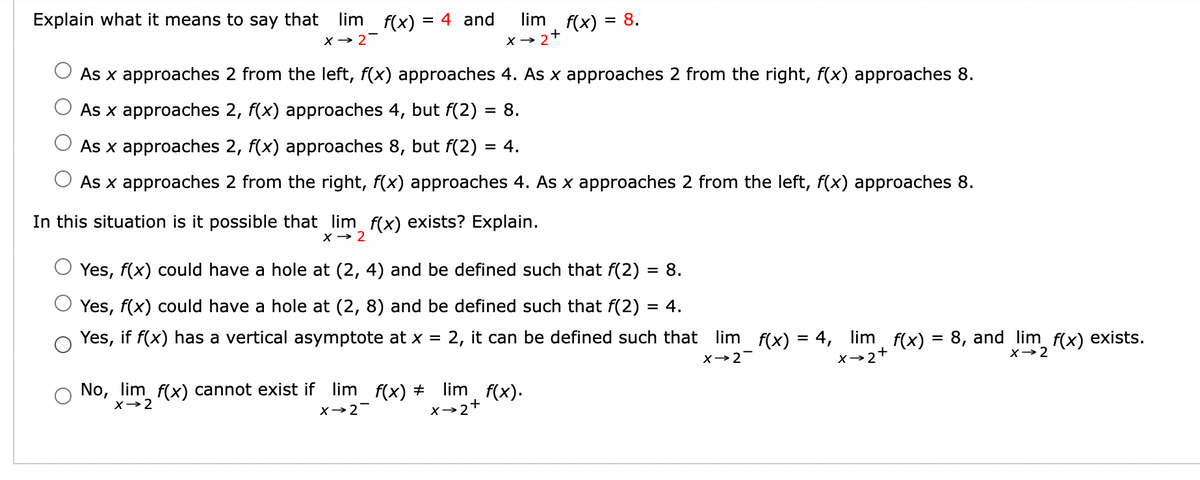lim f(x) = 8. x → 2+ As x approaches 2 from the left, f(x) approaches 4. As x approaches 2 from the right, f(x) approaches 8. As x approaches 2, f(x) approaches 4, but f(2)= 8. As x approaches 2, f(x) approaches 8, but f(2)= 4. As x approaches 2 from the right, f(x) approaches 4. As x approaches 2 from the left, f(x) approaches 8. Explain what it means to say that lim f(x) = 4 and x → 2- In this situation is it possible that lim f(x) exists? Explain. X→ 2 Yes, f(x) could have a hole at (2, 4) and be defined such that f(2)= 8. Yes, f(x) could have a hole at (2, 8) and be defined such that f(2)= 4. Yes, if f(x) has a vertical asymptote at x = 2, it can be defined such that_lim_ f(x) = 4, lim f(x) = 8, and lim f(x) exists. X-2- X→2+ No, lim f(x) cannot exist if lim_f(x) # limf(x). X-2- X→2 x→2+
lim f(x) = 8. x → 2+ As x approaches 2 from the left, f(x) approaches 4. As x approaches 2 from the right, f(x) approaches 8. As x approaches 2, f(x) approaches 4, but f(2)= 8. As x approaches 2, f(x) approaches 8, but f(2)= 4. As x approaches 2 from the right, f(x) approaches 4. As x approaches 2 from the left, f(x) approaches 8. Explain what it means to say that lim f(x) = 4 and x → 2- In this situation is it possible that lim f(x) exists? Explain. X→ 2 Yes, f(x) could have a hole at (2, 4) and be defined such that f(2)= 8. Yes, f(x) could have a hole at (2, 8) and be defined such that f(2)= 4. Yes, if f(x) has a vertical asymptote at x = 2, it can be defined such that_lim_ f(x) = 4, lim f(x) = 8, and lim f(x) exists. X-2- X→2+ No, lim f(x) cannot exist if lim_f(x) # limf(x). X-2- X→2 x→2+
College Algebra (MindTap Course List)
12th Edition
ISBN:9781305652231
Author:R. David Gustafson, Jeff Hughes
Publisher:R. David Gustafson, Jeff Hughes
Chapter3: Functions
Section3.3: More On Functions; Piecewise-defined Functions
Problem 99E: Determine if the statemment is true or false. If the statement is false, then correct it and make it...
Related questions
Question

Transcribed Image Text:Explain what it means to say that lim f(x) = 4 and
x → 2-
lim f(x) = 8.
X→ 2
As x approaches 2 from the left, f(x) approaches 4. As x approaches 2 from the right, f(x) approaches 8.
As x approaches 2, f(x) approaches 4, but f(2) = 8.
As x approaches 2, f(x) approaches 8, but f(2) = 4.
As x approaches 2 from the right, f(x) approaches 4. As x approaches 2 from the left, f(x) approaches 8.
In this situation is it possible that lim f(x) exists? Explain.
X→ 2
No, lim f(x) cannot exist if lim_f(x) ‡
x → 2
X→2-
+
Yes, f(x) could have a hole at (2, 4) and be defined such that f(2)
= 8.
Yes, f(x) could have a hole at (2, 8) and be defined such that f(2) = 4.
Yes, if f(x) has a vertical asymptote at x = 2, it can be defined such that_lim_f(x) = 4,
X→2
lim f(x).
x→2+
limf(x)
4, lim f(x) = 8, and lim f(x) exists.
X→2+
X→ 2
![Use the Intermediate Value Theorem to show that there is a root of the given equation in the specified interval.
ex = 7 - 6x, (0, 1)
and f(1) =
. Since
The equation e* = 7 - 6x is equivalent to the equation f(x) = e* − 7 + 6x = 0. f(x) is continuous on the interval [0, 1], f(0)
there is a number c in (0, 1) such that f(c) = 0 by the Intermediate Value Theorem. Thus, there is a root of the equation e× = 7 − 6x, in the interval (0, 1).
-
---Select--- < 0 <---Select--- ✓
I
=
I](/v2/_next/image?url=https%3A%2F%2Fcontent.bartleby.com%2Fqna-images%2Fquestion%2F05718128-2692-4100-90eb-2bb7bf7cd66e%2Fd215e38a-f8b9-4dad-80d2-7dee7406c843%2F7pr2mv_processed.png&w=3840&q=75)
Transcribed Image Text:Use the Intermediate Value Theorem to show that there is a root of the given equation in the specified interval.
ex = 7 - 6x, (0, 1)
and f(1) =
. Since
The equation e* = 7 - 6x is equivalent to the equation f(x) = e* − 7 + 6x = 0. f(x) is continuous on the interval [0, 1], f(0)
there is a number c in (0, 1) such that f(c) = 0 by the Intermediate Value Theorem. Thus, there is a root of the equation e× = 7 − 6x, in the interval (0, 1).
-
---Select--- < 0 <---Select--- ✓
I
=
I
Expert Solution
This question has been solved!
Explore an expertly crafted, step-by-step solution for a thorough understanding of key concepts.
Step by step
Solved in 2 steps with 1 images

Recommended textbooks for you

College Algebra (MindTap Course List)
Algebra
ISBN:
9781305652231
Author:
R. David Gustafson, Jeff Hughes
Publisher:
Cengage Learning


College Algebra (MindTap Course List)
Algebra
ISBN:
9781305652231
Author:
R. David Gustafson, Jeff Hughes
Publisher:
Cengage Learning
